第3章 噬菌体
噬菌体侵染大肠杆菌实验-3课件高一下学期生物人教版必修2

问题二:1)能否用含32P、35S的培养基之际培养标记噬菌体?如果不能,
该如何标记噬菌体?2)被32P 或35S 标记的噬菌体再侵染什么样的大肠杆菌?
问题三:1)搅拌的目的是什么?2)如果搅拌不充分会造成什么结果?
问题四:1)离心的目的是什么?2)请在下图上写出上清液与沉淀物的放
射性分布情况是怎样的?
问题五:分析:1)被35S标记的噬菌体侵染实验中,为什么沉淀 物也有较低的放射性?2)被32P标记的噬菌体中为什么上清液中 也有较低的放射性?
实验设计
问题1:(1)该实验采用的研究方法是什么?
同位素标记法
(2)分别选用什么放射性元素标记噬菌 体的蛋白质和DNA?为什么? 35S—标记蛋白质,仅蛋白质分子含有硫 32P—标记DNA,磷几乎都存在于DNA中
第3章 第1节 DNA是主要的遗传物质(2)
——二中 生物学
1、说明DNA是主要的遗传物质的原因; 2、分析噬菌体侵染大肠杆菌实验的原理和过程; 3、通过本节课的学习,运用相关知识保护自己及家人 的健康。
回顾:
格里 菲思 实验
艾弗 里的 实验
质疑:
DNA是遗 传物质。
有没有比细菌更为简单的实验材料,只有蛋白质和 DNA。并能够把蛋白质和DNA彻底分开?
A.水和苯酚的作用是分离病毒的蛋白质和 RNAB.TMV的蛋白质没有进入烟草细胞中C.侵入烟 草细胞的RNA含有A、T、G、C四种碱基D.RNA是TMV 的主要遗传物质
DNA是主要的遗传物质
3.科学研究讲究证据。
故事未完待续……
随堂检测
1.下列关于“DNA是生物的主要遗传物质”的叙述正确的是( C )
A.细胞核遗传的遗传物质是DNA,细胞质遗传的遗传物质是 RNAB.肺炎双球菌的转化实验和噬菌体侵染细菌的实验都证明了 DNA是主要的遗传物质
2021-2022高中生物人教版必修2习题:第3章 第1节 DNA是主要的遗传物质
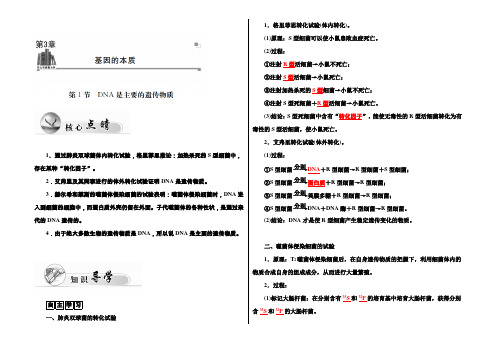
1.通过肺炎双球菌体内转化试验,格里菲思推论:加热杀死的S型细菌中,存在某种“转化因子”。
2.艾弗里及其同事进行的体外转化试验证明DNA是遗传物质。
3.赫尔希和蔡斯的噬菌体侵染细菌的试验表明:噬菌体侵染细菌时,DNA进入到细菌的细胞中,而蛋白质外壳仍留在外面。
子代噬菌体的各种性状,是通过亲代的DNA遗传的。
4.由于绝大多数生物的遗传物质是DNA,所以说DNA是主要的遗传物质。
自主学习一、肺炎双球菌的转化试验1.格里菲思转化试验(体内转化)。
(1)原理:S型细菌可以使小鼠患败血症死亡。
(2)过程:①注射R型活细菌→小鼠不死亡;②注射S型活细菌→小鼠死亡;③注射加热杀死的S型细菌→小鼠不死亡;④注射S型死细菌+R型活细菌→小鼠死亡。
(3)结论:S型死细菌中含有“转化因子”,能使无毒性的R型活细菌转化为有毒性的S型活细菌,使小鼠死亡。
2.艾弗里转化试验(体外转化)。
(1)过程:①S型细菌――→分别DNA+R型细菌→R型细菌+S型细菌;②S型细菌――→分别蛋白质+R型细菌→R型细菌;③S型细菌――→分别荚膜多糖+R型细菌→R型细菌;④S型细菌――→分别DNA+DNA酶+R型细菌→R型细菌。
(2)结论:DNA才是使R型细菌产生稳定遗传变化的物质。
二、噬菌体侵染细菌的试验1.原理:T2噬菌体侵染细菌后,在自身遗传物质的把握下,利用细菌体内的物质合成自身的组成成分,从而进行大量繁殖。
2.过程:(1)标记大肠杆菌:在分别含有35S和32P的培育基中培育大肠杆菌,获得分别含35S和32P的大肠杆菌。
(2)标记T2噬菌体:用分别含35S和32P的大肠杆菌培育T2噬菌体,得到DNA 含有32P标记或蛋白质含有35S标记的噬菌体。
(3)对比试验:用分别含35S和32P的T2噬菌体分别侵染未标记的大肠杆菌。
(4)同位素检测:对两组大肠杆菌培育液进行离心检测。
3.结果:35S标记的T2噬菌体离心后,上清液中放射性高;32P标记的T2噬菌体离心后沉淀物中放射性高。
第3章 消毒与灭菌

长。
37
3.温度
温度升高可增强消毒剂的杀菌效果。温度每增高
l0℃,重金属盐类的杀菌作用约增加2~5倍,石炭酸的杀
菌作用约增加5~8倍。
4.酸碱度
消毒剂杀菌作用受pH影响。如新洁尔灭pH 9时
杀菌作用强。同时pH也影响消毒剂的电离度,一般说,未 电离的分子,较易通过细胞壁,杀菌效果好。 5.有机物 6.药物颉抗 7.其他因素 环境中有机物,可降低消毒剂效果。 两种消毒剂合用时,有的能相互颉抗。如阴 湿度、穿透力、表面张力等。
800nm。可见光线只有微弱的杀菌作用。 2.阳光 直射日光有强烈杀菌作用,是天然杀菌因素,紫外线是日光
杀菌作用的主要因素。许多微生物在直射日光下,半小时到数小时即 可死亡。芽抱的抵抗力强,经20h才死亡。
22
3.紫外线 紫外线中波长200-300nm部分具有杀菌作用,其 中以265-266nm段的杀菌力最强,这与DNA吸收光谱范围一 致。常用的紫外线杀菌灯波长为 253.7nm,杀菌力强而稳定。
14
(1)干热灭菌法 包括火焰灭菌和热空气灭菌两类。
火焰灭菌法是以火焰直接烧灼杀死物体中微生物的方 法。分为灼烧和焚烧两种。 热空气灭菌指利用干热灭菌器以干热空气进行灭菌的 方法。用于耐高温物品。灭菌条件:160℃维持 l-2h,才 能杀死所有微生物(芽孢、孢子)。
15
高压蒸汽灭菌法 最有效的灭菌方法 121 ℃ 20~30分钟 煮沸消毒法 水煮100 ℃ 5分钟(繁殖体)~2小时(芽胞) 流通蒸汽消毒法 水蒸汽100 ℃ 15~30分钟(繁殖体) 巴氏消毒法 较低的温度(61 ℃ 30分钟)杀灭致病菌 间歇蒸汽灭菌法 反复多次流动蒸汽间歇加热灭菌
17
巴氏消毒法具体方法有三种
第3-5章 噬菌体、遗传变异、耐药性

一、 细菌的变异现象
1、形态结构变异
❖ 细菌L型——在青霉素、溶菌酶、补体等作用下,使菌细 胞壁发生缺陷;细菌呈多态性,革兰染色阴性。
❖ H-O变异——细菌失去鞭毛
陈旧培基物
鼠疫杆菌
多形态性
变形杆菌(Proteus) 鞭毛变异,H--O变异
葡萄球菌--- L 型菌落
葡萄球菌---回复后
2、毒 力 变 异
普遍性转导与局限性转导的区别
区别要点 转导发生的时期 转导的遗传物质
转导的后果
转导频率
普遍性转导
局限性转导
裂解期
溶原期
供体菌染色体DNA任何部位或质 噬菌体DNA及供体菌DNA
粒
的特定部位
完全转导或流产转导
受体菌获得供体菌DNA特 定部位的遗传特性
受体菌的10-7
转导频率较普遍转导增加 1000倍
三、干扰蛋白质合成的抗菌药物有:
1)影响氨酰-tRNA合成:莫匹罗星 2)影响核糖体功能:氨基糖苷类、四环素类
四、影响核酸合成和叶酸代谢:
1)博来霉素:断裂DNA 2)利福霉素:抑制转录延伸 3)多柔比星和柔红霉素:拓扑异构酶II抑制剂 4)新生霉素:DNA回旋酶抑制剂 5)甲氧苄啶(TMP)(抑制二氢叶酸合成酶)和磺胺(干扰叶酸代谢)
性菌毛有关 与耐药性有关 编码大肠菌素 与细菌毒力有关 与代谢相关的酶类
(三)转座因子(Transposable element)“Jump Gene”
是细菌基因组中能改变自身位置的一段DNA序列,由其 移动可引起插入突变、染色体畸变及基因的重排等,从而导 致细菌遗传性状改变。转座现象的发现,证明基因是在不断 改变遗传组成的动态有机体。(McClintock,1983诺奖)
人教版生物必修二同步讲义:第3章 第1节 DNA是主要的遗传物质含答案
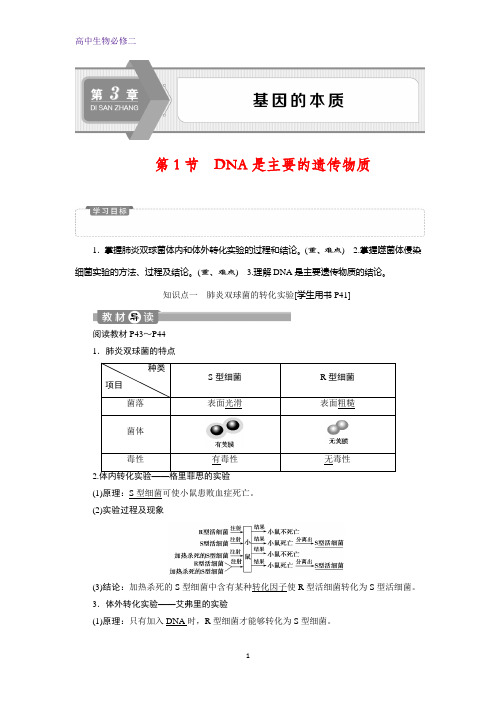
第1节DNA是主要的遗传物质1.掌握肺炎双球菌体内和体外转化实验的过程和结论。
(重、难点) 2.掌握噬菌体侵染细菌实验的方法、过程及结论。
(重、难点) 3.理解DNA是主要遗传物质的结论。
知识点一肺炎双球菌的转化实验[学生用书P41]阅读教材P43~P441.肺炎双球菌的特点种类S型细菌R型细菌项目菌落表面光滑表面粗糙菌体毒性有毒性无毒性2.体内转化实验——格里菲思的实验(1)原理:S型细菌可使小鼠患败血症死亡。
(2)实验过程及现象(3)结论:加热杀死的S型细菌中含有某种转化因子使R型活细菌转化为S型活细菌。
3.体外转化实验——艾弗里的实验(1)原理:只有加入DNA时,R型细菌才能够转化为S型细菌。
(2)过程(3)结论:DNA才是使R型细菌产生稳定遗传变化的物质。
1.肺炎双球菌体内转化实验和体外转化实验的比较项目体内转化实验体外转化实验培养细菌在小鼠体内体外培养基实验对照R型细菌与S型细菌的毒性对照S型细菌各组成成分的作用进行对照巧妙构思用加热杀死的S型细菌注射到小鼠体内作为对照实验来说明确实发生了转化将物质提纯分离后,直接、单独地观察某种物质在实验中所起的作用实验结论S型细菌体内有“转化因子”S型细菌的DNA是遗传物质联系(1)所用材料相同;(2)体内转化实验是体外转化实验的基础,体外转化实验是体内转化实验的延伸;(3)两个实验都遵循对照原则、单一变量原则2.实验拓展分析(1)在加热杀死S型细菌的过程中,其蛋白质变性失活,但是其内部的DNA在加热结束后随温度的降低又逐渐恢复活性。
(2)转化的实质是S型细菌的DNA片段整合到了R型细菌的DNA中。
(3)在转化实验中,使小鼠致死的是S型细菌,不是S型细菌的DNA。
1.(2019·菏泽高一检测)在肺炎双球菌转化实验中,将R型活细菌与加热杀死的S型细菌混合后,注射到小鼠体内,下列能在死亡小鼠体内出现的细菌类型有()①有毒的R型活细菌②无毒的R型活细菌③有毒的S型活细菌④无毒的S型活细菌A.①④B.②③C.③D.①③[答案]B2.(2019·北京延庆高一期末)下图表示肺炎双球菌的转化实验,下列相关叙述错误的是()A.DNA酶的作用是水解S型菌的DNAB.结果1中S型肺炎双球菌占绝大多数C.该实验证明DNA是遗传物质D.结果2中全部为R型肺炎双球菌[解析]选B。
第3章 基因的本质 (3)
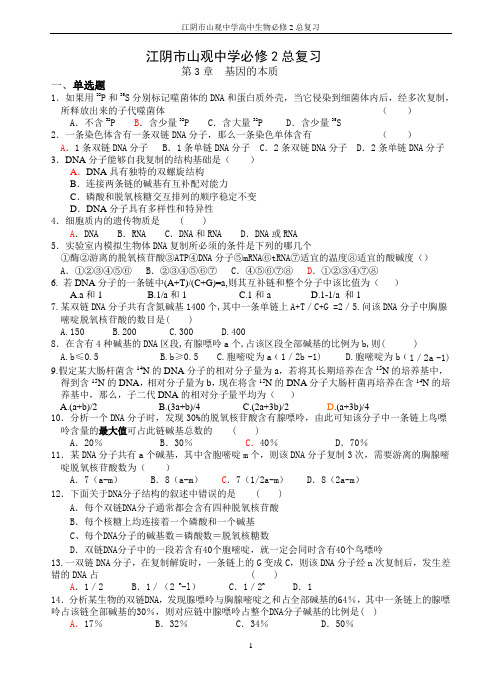
江阴市山观中学必修2总复习第3章基因的本质一、单选题1.如果用32P和35S分别标记噬菌体的DNA和蛋白质外壳,当它侵染到细菌体内后,经多次复制,所释放出来的子代噬菌体()A.不含32P B.含少量32P C.含大量32P D.含少量35S2.一条染色体含有一条双链DNA分子,那么一条染色单体含有()A.1条双链DNA分子 B.1条单链DNA分子 C.2条双链DNA分子 D.2条单链DNA分子3.DNA分子能够自我复制的结构基础是()A.DNA具有独特的双螺旋结构B.连接两条链的碱基有互补配对能力C.磷酸和脱氧核糖交互排列的顺序稳定不变D.DNA分子具有多样性和特异性4.细胞质内的遗传物质是 ( )A.DNA B.RNA C.DNA和RNA D.DNA或RNA5.实验室内模拟生物体DNA复制所必须的条件是下列的哪几个①酶②游离的脱氧核苷酸③ATP④DNA分子⑤mRNA⑥tRNA⑦适宜的温度⑧适宜的酸碱度()A.①②③④⑤⑥ B.②③④⑤⑥⑦ C.④⑤⑥⑦⑧D.①②③④⑦⑧6. 若DNA分子的一条链中(A+T)/(C+G)=a,则其互补链和整个分子中该比值为()A.a和1B.1/a和1C.1 和aD.1-1/a 和17.某双链DNA分子共有含氮碱基1400个,其中一条单链上A+T/C+G =2/5.问该DNA分子中胸腺嘧啶脱氧核苷酸的数目是( )A.150B.200C.300D.4008.在含有4种碱基的DNA区段,有腺嘌呤a个,占该区段全部碱基的比例为b,则( )A.b≤0.5B.b≥0.5C.胞嘧啶为a﹙1/2b -1)D.胞嘧啶为b﹙1/2a -1)9.假定某大肠杆菌含14N的DNA分子的相对分子量为a,若将其长期培养在含15N的培养基中,得到含15N的DNA,相对分子量为b,现在将含15N的DNA分子大肠杆菌再培养在含14N的培养基中,那么,子二代DNA的相对分子量平均为()A.(a+b)/2B.(3a+b)/4C.(2a+3b)/2D.(a+3b)/410.分析一个DNA分子时,发现30%的脱氧核苷酸含有腺嘌呤,由此可知该分子中一条链上鸟嘌呤含量的最大值可占此链碱基总数的 ( )A.20% B.30%C.40% D.70%11.某DNA分子共有a个碱基,其中含胞嘧啶m个,则该DNA分子复制3次,需要游离的胸腺嘧啶脱氧核苷酸数为()A.7(a-m) B.8(a-m)C.7(1/2a-m) D.8(2a-m)12.下面关于DNA分子结构的叙述中错误的是 ( )A.每个双链DNA分子通常都会含有四种脱氧核苷酸B.每个核糖上均连接着一个磷酸和一个碱基C、每个DNA分子的碱基数=磷酸数=脱氧核糖数D.双链DNA分子中的一段若含有40个胞嘧啶,就一定会同时含有40个鸟嘌呤13.一双链DNA分子,在复制解旋时,一条链上的G变成C,则该DNA分子经n次复制后,发生差错的DNA占 ( )A.1/2 B.1/(2 n-l)C.1/2n D.114.分析某生物的双链DNA,发现腺嘌呤与胸腺嘧啶之和占全部碱基的64%,其中一条链上的腺嘌呤占该链全部碱基的30%,则对应链中腺嘌呤占整个DNA分子碱基的比例是( ) A.17% B.32% C.34% D.50%15.作为遗传物质应具备的特点是()①分子结构具有相对稳定性②能自我复制,保持上下代连续性③能指导蛋白质合成④能产生可遗传变异⑤能指导蛋白质的分解,形成氨基酸⑥分子结构具有多变性A.①②③⑤B.①②③④C.②③④⑥D.③④⑤⑥16.在噬菌体侵染细菌的实验中,证明DNA是遗传物质的关键是()A.噬菌体吸附在细菌细胞上B.噬菌体把DNA注入到细菌体内而蛋白质外壳留在细菌体外C.释放的子代噬菌体与感染噬菌体相同D.DNA有自我复制现象17.一段多核苷酸链中的碱基组成为:35%的A、20%的C、35%的G、10%的T。
微生物练习册第三章
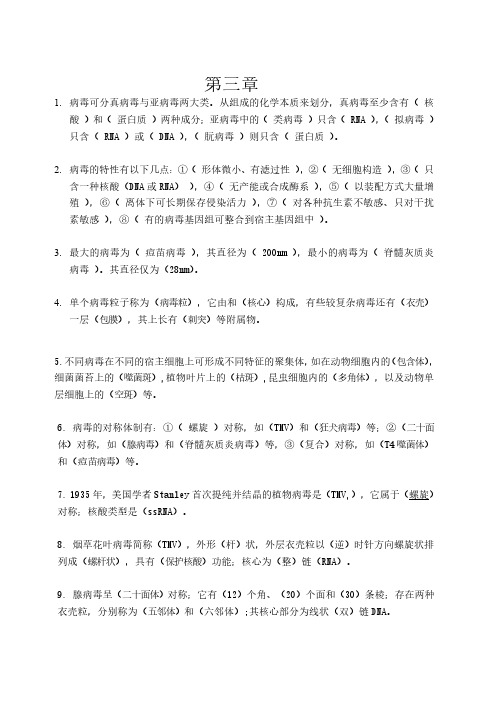
24. 昆虫病毒主要有三类,即(核型多角体病毒)和典型的类病毒是由美国学者于 19H 年发现的(质型多角体病毒),它的成分是一种(颗粒体病毒)分子。
5.腺病毒的衣壳由 252 个衣壳粒构成,其中包括 12 个六邻体和 240 个五邻体。(×) 12 个五邻体(分布在 12 个顶角)和 240 个六邻体
6.E.coli T 偶数噬菌体的核心是由线状双链 DNA 构成的。(√) 7.动物病毒的核心多数为线状的双链 DNA 或单链 RNA。(√) 8.植物病毒的核心多数由线状单链 RNA 构成。(√) 9.大肠杆菌的入噬菌体是一种典型的温和噬菌体。(√)
A.脊髓灰质炎病毒B.烟草花叶病毒
C.昆虫多角体病毒 D. 痘 苗 病
毒
5. 真菌、细菌、病毒三者直径的大致比例是(D)。
A. 10 : 5 : 1
B. 10 : 6 : 4 C. 100 : 50 : 2 D. 100 : 10 : 1
6. 狂犬病毒的形状为枪弹状,它的对称体制是(A)。
A.螺旋对称 B.二十面体对称 C.复合对称 D.以上都不是
4.腺病毒是一种呈二十面体对称的 DNA 病毒,在其包膜上,长有 12 个刺突。(×) 腺病毒是一种无包膜的双链 DNA 病毒,衣壳
(capsid)呈规则的 20 面体结构。衣壳含有 240 个六联体(he×on)、12 个五联体(penton)及 12 根纤毛(fiber),除此之外还有其他一些小 蛋白,如 VI、VIII、I×、IIIa 和 IVa2 等。六 联体是形成病毒衣壳 20 个三角形面的主要蛋白, 12 个顶端是 5 个五联体亚单位和 3 个纤毛蛋白 构成的复合物,12 根纤毛以五联体蛋白为基底由衣壳表面伸出,纤毛顶端形成头节区(knob)。
第3.4章噬菌体细菌遗传与变异
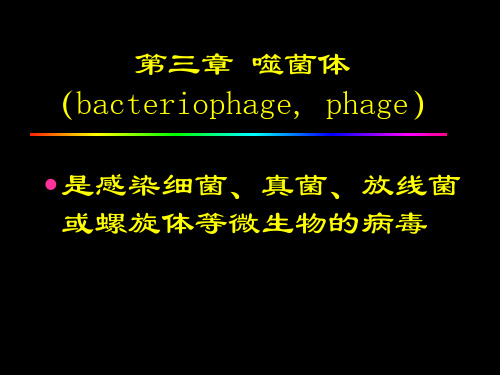
细菌遗传变异在医学上的实际意义
一、影响细菌学诊断 二、预防耐药菌株的扩散 三、制备疫苗 四、检测致癌物 五、基因工程方面的应用
复习要点
• 名词解释 转化、接合、转导、溶原性转换、毒性噬 菌体、温和噬菌体、前噬菌体、溶原性细 菌、普遍性转导、局限性转导
有荚膜肺炎链球菌 (活菌)IIIS
无荚膜肺炎链球菌 (活菌)IIR
分离出 ⅢS
有荚膜肺炎链球菌 (死菌)IIIS
IIR活菌+IIIS死菌 或
IIR活菌+提取的IIIS DNA
分离出 ⅢS型有 荚膜的活 菌
(二)接合 conjugation
• 供体菌通过性菌毛将遗传物质 (质粒)传递给受体菌
• 接合性质粒——能通过接合方式 转移的质粒(F质粒、R质粒等)
▪ 但由于噬菌体过于专一,限制了噬菌体 在临床上的广泛应用
第四章 细菌的遗传与变异
细菌变异的现象
• 形态结构变异 • 抗原性变异 • 菌落变异 • 毒力变异 • 耐药性变异
• 遗传性变异:
是微生物的基因结构发生了改变, 故又称基因型变异
常发生于个别的微生物,不受环 境因素的影响,变异发生后是不 可逆的,产生的新性状可稳定地 遗传给后代
• 毒性噬菌体的溶菌周期(复制周期)
吸附→释放子代噬菌体——噬菌体的复 制周期
• 增殖过程
吸附——穿入——生物合成——成熟与释放
毒性噬菌体溶菌现象
• 液体培养基:使浑浊菌液变为澄清
固体培养基:若用适量噬菌体和宿主菌 液混合后接种培养,培养基表面可有透 亮的溶菌空斑出现
一个空斑系由一个噬菌体复制增殖并 裂解细菌后形成的,称为噬斑
噬菌体知识点总结

噬菌体知识点总结一、噬菌体的结构噬菌体的结构包括头部、尾部和纤毛等部分。
头部包含病毒的遗传物质(DNA或RNA),尾部和纤毛负责连接并注射病毒的遗传物质到细菌内。
噬菌体具有一定的遗传物质,有些噬菌体还带有一些蛋白质酶和结构蛋白,其结构紧凑而高效,能有效感染细菌。
二、噬菌体的生命周期噬菌体的生命周期包括寄主细胞感染、复制、组装和释放等多个阶段。
当噬菌体感染到细胞表面后,病毒会通过尾部和纤毛注射遗传物质到细胞内,遗传物质随后开始复制并制造新的病毒颗粒。
最终,新的病毒颗粒会组装成完整的噬菌体,并释放到环境中去感染其他细菌。
三、噬菌体在医学领域的应用噬菌体可以作为一种天然的抗菌剂,用于治疗多种细菌感染疾病,如肺炎、脑膜炎、败血症等。
由于细菌对抗生素产生抗药性的问题日益严重,噬菌体治疗被认为是一种非常有前景的替代方法。
目前已有一些临床试验表明,噬菌体治疗在治疗细菌感染方面具有显著效果,且对人体没有明显的毒副作用。
四、噬菌体在农业领域的应用在农业生产中,细菌性疾病是造成农作物减产和质量下降的重要原因。
而噬菌体可以作为一种天然的抗菌剂,用于预防和治疗作物上的细菌性疾病。
例如,噬菌体可以用于防治番茄、土豆、玉米等作物上的细菌性病害,取得了良好的防治效果。
五、噬菌体在食品工业领域的应用由于其对细菌的高效杀灭作用,噬菌体可以被用于食品加工和保存中。
例如,在食品加工中,可以使用噬菌体对肉类、奶制品等食品中的细菌进行控制,延长食品的保质期。
此外,噬菌体还可以被用于抑制食品中的致病菌,保障食品的安全性。
六、噬菌体的未来发展方向随着人们对抗生素耐药性的关注不断增加,噬菌体治疗作为一种替代疗法,具有广阔的应用前景。
在未来的研究中,可以通过基因工程技术对噬菌体进行改良,使其更加高效、安全和稳定,以满足不同领域应用的需求。
同时,研究人员还可以进一步深入了解噬菌体的生存机制和感染方式,以拓展其在医学、农业和食品工业等领域的应用范围。
3基础微生物第四章噬菌体 第五章细菌遗传变异

余氵 贺 1933~1988
1958年,广慈医院在抢救大 面积烧伤工人邱财康期间, 为快速抑制绿脓杆菌的繁殖 ,余氵 贺 教授亲自带领师生到 郊外便池采集了几十种噬菌 体,选择其中噬菌力特别强 的应用于临床,攻克了绿脓 杆菌的感染,保全了邱财康 的肢体,使抢救工作顺利进 行,创造了我国烧伤史上的 奇迹。
39
4、整合子(integron,In)
是一种运动性的DNA分子, 能捕获和整合外源性基因, 使之成为功能性基因表达的基因元件。 可存在于染色体、质粒或转座子上。
Stokes HW,Hall RM.A Novel family of potentially mobile DNA elements encoding site-specific gene integration functions: integrons.Microbial,1989.
前噬菌体prophage: 整合在细菌基因组中 的噬菌体基因组
溶原性细菌
44
前噬菌体引起宿主菌的溶原性转化; 前噬菌体能整合到细菌染色体的任一位置, 改变细菌的某些生物学性状。 如大肠埃希菌温和性噬菌体Mu (mutator phage,诱变噬菌体)。
可作为生物诱变剂,研究细菌变异的工具。
45
二、细菌变异的机制
第三章 噬菌体 bacteriophage
1
2
噬菌体
感染细菌、真菌、放线菌或螺旋体等微生物的
病毒的总称。
个体微小,可以通过细菌滤器;
无细胞结构,主要有蛋白质构成的衣壳和包含
于其中的核酸组成;
为专性细胞内寄生的微生物。 不能独立生存, 噬菌体与宿主细胞之间的特异性
3
主要内容
噬菌体的生物学性状 噬菌体与宿主菌的关系 毒性噬菌体,温和噬菌体 噬菌体的应用
第三章病毒和亚病毒一、名词解释1.病毒2.真病毒3.亚病毒4.噬菌斑5

第三章病毒和亚病毒一、名词解释:1.病毒2.真病毒3.亚病毒4.噬菌斑5.烈性噬菌体6.温和噬菌体7.溶源性细菌8.原噬菌体9.自发裂解10.诱发裂解11.包涵体12.半致死剂量13.卫星RNA14.类病毒15.一步生长曲线16.逆转录病毒17.噬菌斑二、填空题1.病毒的存在范围是病毒能够感染并在其中复制的()。
2.从原核生物中分离的病毒统称噬菌体,它们包括()、()和()等。
3.病毒属名的词尾是()、科名的词尾是()、亚科名的词尾是(),目名的词尾是()。
4.纯化的病毒制备物应保持其()和()。
5.血凝抑制试验是根据异性的病毒抗体与病毒表面蛋白作用可能抑制()性质设计的。
6.螺旋对称病毒体的直径是由()决定的,而其长度则是由()所决定的。
7.病毒蛋白质根据其是否存在于毒粒中分为()和()两类。
8.病毒包膜糖蛋白是由多肽链骨架与寡糖侧链,通过()将糖链的()与肽链的()连接形成。
9.由一步生长曲线可获得病毒繁殖的两个特征性数据,即潜伏期和裂解量。
前者为所需的最短的时间,后者为()的平均数目。
10.病毒的复制过程依其发生事件顺序分为以下()、()、()、()和()5个阶段。
11.病毒在寄主体外,很易因外界环境如高温,射线等作用而();带封套的病毒容易被()破坏,因而可用消毒剂如()来消毒。
12.溶源性细胞在正常情况下有大约10-5细胞会发生()现象,这是由于少数溶源细胞中的()变成了()的缘故。
13.温和噬菌体能以()整合在寄主胞的染色体上,形成()细胞,该细胞具有()、()、()、()、()等几个特征(填三个特征即可)。
14.烈性噬菌体入侵寄主的过程可分为()、()、()、()、()等五个阶段。
.15.TMV病毒粒子的形状为(),所含核酸为()。
16.T4噬菌体感染寄主细胞依靠()将()注入寄主细胞。
17.检查细菌是否被噬菌体感染的方法,通常是()、()。
18.一种病毒只含一种核酸,即()或();植物病毒多为()病毒;噬菌体多为()病毒。
第3章 噬菌体

2.化学组成:蛋白质有保护核酸的作用。 3.抗原性:产生的特异性抗体有阻止侵袭宿
主菌的作用。
4.抵抗力:较细菌繁殖体抵抗力强。
第பைடு நூலகம்节
毒性噬菌体
1.概念:能在宿主菌细胞内复制增殖,最终裂
解细菌并释放子代噬菌体。
与宿主菌的关系:噬菌体增殖,宿主菌裂解,
称为溶菌,该过程称为溶菌性周期。
溶菌性周期:从噬菌体吸附至细菌到细
菌溶解释放出子代噬菌体的全过程。
分四个阶段: 吸附 穿入 生物合成 装配与释放。
成熟 释放
吸附
生物 合成
穿入
噬菌体的增殖过程
吸附
穿入
成熟、释放
生物合成
毒性噬菌体的溶菌性周期
毒性噬菌体的溶菌性周期
在液体培养基中,噬菌体裂解宿主菌可 使混浊菌液变澄清; 在固体培养基上,将适量噬菌体和宿主 菌液混合接种培养后,培养基表面可出现透 明的溶菌空斑,每个空斑是由一个噬菌体增 殖并裂解宿主菌后形成的,称为噬斑。
第三章 噬菌体(bacteriophage)
是感染细菌、真菌、放线菌、螺旋体等微
生物的病毒。
基本特性:
小 无细胞结构 具有严格的宿主特异性
第一节 噬菌体的生物学性状
1.形态结构
微小,电镜观察。
形态:蝌蚪形(多数)、微球形、杆状。
结构:蝌蚪形由头、尾两部分组成。 核酸(DNA或RNA), 蛋白质(头部衣壳和尾部)。
第三节
温和噬菌体
1.概念:在宿主菌细胞内发生基因组整合,
并随细菌分裂而分配至子代细菌的染色体中, 不引起细菌裂解。 噬菌体核酸整合,宿主菌仍可生长繁殖,
称为溶原,该过程称溶原性周期。
温和噬菌体的溶原性周期
人教版高中生物必修二第三章第一节《噬菌体侵染细菌的实验》教学设计

噬菌体侵染细菌实验临漳县第一中学王军强一、教学设计理念苏霍姆林斯基说过:“人的心灵深处有一种根深蒂固的需要,就是希望自己是一个发现者、研究者、探究者”。
本课内容引导学生体会科学家的工作方式和研究方式,深入理解生物学原理,感悟科学研究的基本过程与方法,促使学生领悟科学观念,培养科学探究精神。
本课采用问题引导呈探究过程→分析实验结果→得出结论→提出质疑→引入下一个实验”的教学程序,使各个实验一环扣一环,认识到科学实验在一步一步地完善,最后才得出最具说服力的结论,并体会到科学研究的严谨性。
二、教材分析:《DNA是主要的遗传物质》是人教版普通高中课程标准实验教科书生物必修二第三章第一节内容。
是继前两章学习了“遗传因子的发现”和“基因和染色体的关系”后,对有关细胞学基础(有丝分裂、减数分裂和受精作用)、染色体在前后代遗传中所起的联系作用、染色体的主要成分是DNA和蛋白质等知识有了一定的理解后来学习的。
《DNA是主要的遗传物质》主要讲述了DNA是遗传物质的直接证据“肺炎双球菌转化实验”和“噬菌体侵染细菌实验”,体现了科学家在进行科学探究的一般思维过程,从早期对于遗传物质的推测,到中期通过肺炎双球菌转化实验的探索,到后期噬菌体侵染细菌实验的验证,整个过程体现了科学探究的严谨的思维历程,与前面第一章和第二章所学的科学研究方法假说演绎法与类比推理法遥相呼应,是进行科学研究方法渗透的典型教学案例。
本节课的教学内容涉及的实验,无法在现有的实验室条件完成,所以采用了引导探究式的教学方法,通过创设自主合作的学习情景、平等融洽的人际环境,激发学生的学习积极性,学生积极主动地走进科学家的探究历程,在观察和思考中,愉快地学习,处于主体地位。
本节内容既对前两章的基因的有关知识作本质性的阐述,也下启后三节关于DNA分子的结构、复制和遗传效应等,具有承上启下的作用。
三、教学目标1.知识目标了解“同位素标记法”在噬菌体侵染细菌的实验中的运用。
微生物学练习题(第三章-病毒)
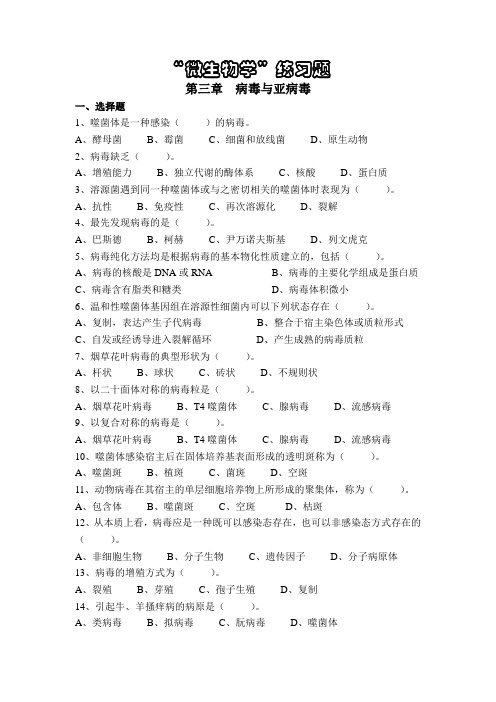
“微生物学”练习题第三章病毒与亚病毒一、选择题1、噬菌体是一种感染()的病毒。
A、酵母菌B、霉菌C、细菌和放线菌D、原生动物2、病毒缺乏()。
A、增殖能力B、独立代谢的酶体系C、核酸D、蛋白质3、溶源菌遇到同一种噬菌体或与之密切相关的噬菌体时表现为()。
A、抗性B、免疫性C、再次溶源化D、裂解4、最先发现病毒的是()。
A、巴斯德B、柯赫C、尹万诺夫斯基D、列文虎克5、病毒纯化方法均是根据病毒的基本物化性质建立的,包括()。
A、病毒的核酸是DNA或RNAB、病毒的主要化学组成是蛋白质C、病毒含有脂类和糖类D、病毒体积微小6、温和性噬菌体基因组在溶源性细菌内可以下列状态存在()。
A、复制,表达产生子代病毒B、整合于宿主染色体或质粒形式C、自发或经诱导进入裂解循环D、产生成熟的病毒质粒7、烟草花叶病毒的典型形状为()。
A、杆状B、球状C、砖状D、不规则状8、以二十面体对称的病毒粒是()。
A、烟草花叶病毒B、T4噬菌体C、腺病毒D、流感病毒9、以复合对称的病毒是()。
A、烟草花叶病毒B、T4噬菌体C、腺病毒D、流感病毒10、噬菌体感染宿主后在固体培养基表面形成的透明斑称为()。
A、噬菌斑B、植斑C、菌斑D、空斑11、动物病毒在其宿主的单层细胞培养物上所形成的聚集体,称为()。
A、包含体B、噬菌斑C、空斑D、枯斑12、从本质上看,病毒应是一种既可以感染态存在,也可以非感染态方式存在的()。
A、非细胞生物B、分子生物C、遗传因子D、分子病原体13、病毒的增殖方式为()。
A、裂殖B、芽殖C、孢子生殖D、复制14、引起牛、羊搔痒病的病原是()。
A、类病毒B、拟病毒C、朊病毒D、噬菌体15、1971年,T.O.Diener在患仿锤病的马铃薯块茎中,发现了最小的只含有裸露RNA分子的寄生生物()。
A、类病毒B、拟病毒C、核形多菌体病毒D、颗粒体病毒16、病毒壳体的组成成分是()。
A、核酸B、蛋白质C、多糖D、脂类17、组成病毒粒子核髓的化学成分是()。
2018年高中生物必修二课件:第3章 第1节 第2课时 噬菌体侵染细菌的实验和生物的遗传物质

第2课时 噬菌体侵染细菌的实验和生物的 遗传物质
学习 目标
1.概述噬菌体的结构及增殖的过程。 2.分析噬菌体侵染细菌的实验过程,解释放射性分布不同的原因以及结论。 3.概述不同生物的遗传物质。
栏目 索引
基础知识导学 重点难点探究 随堂达标检测
基础知识导学
一、噬菌体侵染细菌的实验
解析答案
二、生物的遗传物质 结合所学,完成下表并分析:
生物类型
细胞生物
真核生物 原核生物
非细胞生物
大多数病毒 极少数病毒
所含核酸 DNA和RNA DNA和RNA
DNA RNA
遗传物质 DNA DNA DNA RNA
1.人、噬菌体、烟草花叶病毒及大肠杆菌的遗传物质分别是什么? 答案 分别是DNA、DNA、RNA、DNA。
A.31P
B.32P
C.32S
D.35S
解析 噬菌体侵染细菌时,进入细菌体内的只有DNA,蛋白质外壳保留 在外面,因此在子代噬菌体中不可能含有32S。
解析答案
12345
3.某生物兴趣小组模拟赫尔希和蔡斯做了噬菌体侵染细菌的实验,如图。 下列有关分析不正确的是( )
A.理论上,b中不应具有放射性 B.b中含放射性的高低,与②过程中搅拌是否充分有关 C.若b中含有放射性,说明与①过程中培养时间的长短有关 D.上述实验过程并不能证明DNA是遗传物质
答案
返回
随堂达标检测
12345
1.赫尔希和蔡斯通过T2噬菌体侵染细菌的实验证明DNA是遗传物质,实验 包括六个步骤:①噬菌体侵染细菌;②设法用35S或32P标记噬菌体;
③上清液和沉淀物的放射性检测;④离心分离;⑤子代噬菌体的放射性检
生物必修二第3章

3.1DNA是主要的遗传物质一.对遗传物质的早期推测二.肺炎双球菌的转化实验1.格里菲斯体内转化实验R型菌:无荚膜,无毒,菌落粗糙S型菌:有荚膜,有毒,使人患肺炎,使小鼠患败血症死亡,菌落光滑结论:S型细菌中存在某种转化因子使R型菌转化成S型细菌2.艾弗里体外转化实验结论:转化因子是DNA,即DNA是遗传物质,其他物质不是三.赫尔希和蔡斯的噬菌体侵染细菌的实验1.T2噬菌体:专门侵染大肠杆菌,将DNA 注入大肠杆菌体内,蛋白质外壳留在外侧,借助大肠杆菌体内的原料进行自身DNA 的复制以及蛋白质外壳的合成,然后重新组装成新的个体,,达到一定数量时,大肠杆菌裂解,释放新的T2噬菌体注:上清液中含有未侵染的T 2噬菌体和侵染后的T 2噬菌体外壳,沉淀物中含有被感染的细菌。
※ ①此实验用同位素标记法,巧妙地将噬菌体的和核酸和蛋白质分开,单独地直接地观察两者在遗传上的作用。
※ ②因噬菌体蛋白质含有DNA 没有的特殊元素S ,所以用35S 标记蛋白质;DNA含有蛋白质没有的特殊元素P ,所以用32P 标记DNA ,因为DNA 和蛋白质都含有C 、H 、O 、N 元素,所以此实验不能标记C 、H 、O 、N 元素。
四.RNA 是遗传物质(少数病毒):烟草花叶病毒感染烟草RNA →感染病毒 1.过程:烟草花叶病毒→蛋白质→→未感染病毒2.结论:在RNA 病毒中,RNA 是遗传物质3.例举以DNA 作为遗传物质的生物:细胞生物(原、真核生物)、DNA 病毒。
(一般只要是有DNA ,就以它为遗传物质)4.例举以RNA 作为遗传物质的生物:烟草花叶病毒、流感病毒、艾滋病病毒(一般在只有RNA 时,才以它为遗传物质)5.总结:DNA 是主要的遗传物质3.2DNA 分子的结构一.DNA 双螺旋结构模型的构建二.DNA 分子的结构 1.化学组成2.空间结构3.遗传信息:DNA 分子中的碱基对排列顺序就代表了遗传信息4.碱基互补配对原则应用5.DNA和RNA的比较3.3DNA的复制一.对DNA分子复制的推测二.DNA半保留复制的实验证据1.实验方法:同位素示踪技术2.实验原理:根据离心后DNA带在试管中的位置判断,密度越大,位置越低3.实验过程:4.结论:DNA进行半保留复制三.DNA复制过程1.DNA复制:指以亲代DNA分子为模板来合成子代DNA的过程。
第3章ab 微生物生理学

•
自我组装是大分子之间相互作用的结 果,只有在分子表面的结构互相弥补时, 两个大分子才能紧密连接和相互结合 , 并 在合适条件下能按一定的程序和规律自行 装配成更高一级的结构,以执行细胞的各 种功能。
一、T4噬菌体的组装
噬菌体T4的结构 1. 头部的组装 2.尾部的组装 3.完整T4 phaeg组装 4. 顺序与定时.
1.组装过程:
(1) 在细胞质中合成N-乙酰葡糖胺和N-乙酰胞壁酸
图3.16
由N-乙酰胞壁酸合成UDP-NAM-五肽(“Park”核苷酸)
图3.17
(2) 在膜中,由转移酶催化,将UDP-NAG 与 undPP - NAM - PentaAA 结合,形成肽 聚糖的重复单位,放出UDP。
革兰氏阳性菌在膜中形成肽桥,是在 ATP 和 tRNA 参 与 下 , 先 生 成 氨 基 酰 - tRNA,然后一个一个通过肽键连结起来。
种大分子参与穿越过程
图3.12
6
• 四、信号序列识别颗粒(SRP)
存在于细胞质内,哺乳动物的SRP包含 一个7sRNA和6条多肽链,这6条肽链形成3 个异聚体。
五、SRP的受体(SRPR)
SRPR由两个亚基组成,作用:一是介导 正在合成肽链的核糖体与膜结合,二是同 时结束SRP的循环,再生游离的SRP。
(3) 在细胞膜外的周质空间合成 周质空间
图3.19
G细 菌
图3.20
G+ 细 菌
4
3
UDP-NAG
UDP-NAM
2 1 图3.21
二、外膜的组装
(Assembly of outer membrane)
1.LPS 的组装 LPS 亚单位是在细胞膜内合成,是两个 平行的过程。 (1) 在und-P上形成多糖侧链,聚合酶作用。 ( 2 ) 在脂 A 上组装上核心寡糖,膜上的糖核 苷酸转移酶催化。
必修二第三章第一节噬菌体侵染大肠细菌的实验
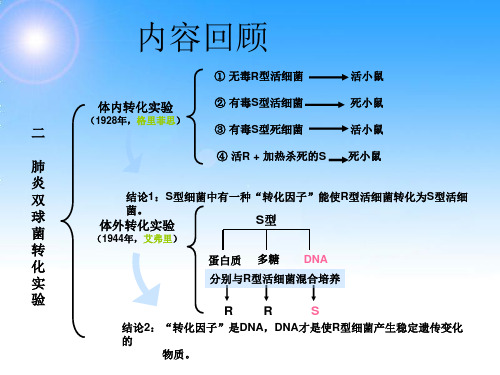
烟草花叶病病毒
烟草花叶病
分析“烟草花叶病毒重建实验”
蛋 白 质
(TMV)
RNA
实验证明:烟草花叶病毒(TMV)的遗 传物质是RNA
[相关链接]SARS病毒的结构:
?
所有生物的遗传物质都是DNA吗?
蛋白质 RNA
遗传物质除了DNA外,还有RNA 。
原核生物的遗传物质为DNA 真核生物的遗传物质为DNA 噬菌体的遗传物质为DNA HIV、SARS病毒的遗传物质为RNA
1、 T2 噬菌体的结构组成为 :
A、蛋白质、脂类 B、糖类、蛋白质 C、蛋白质、DNA D、蛋白质、RNA
2、“DNA是主要的遗传物质”是指:
A、遗传物质的主要载体是染色体 B、大多数生物的遗传物质是DNA
C、细胞里的DNA大部分在染色体上
D、染色体在遗传上起主要作用
课堂练习
3、噬菌体侵染细菌的正确顺序是 :
第一步:标记大肠杆菌 细菌+含35S的培养基 含35S的细菌
细菌+含32P 的培养基
第二步:标记噬菌体
含32P的细菌
噬菌体+含35S的细菌 噬菌体+含32P的细菌
含35S的噬菌体 含32P的噬菌体
实验思路: 1.标记大肠杆菌:
2.标记噬菌体: 3. 标记的噬菌体分别侵染未标记的大肠杆菌: 上清液(培养液) 4. 搅拌离心培养液: 沉淀物(大肠杆菌含子代噬菌体) 5.观察放射性
离心
离心
实验结果
亲代噬菌体
35S
寄主细菌内
(大肠杆菌)
子代噬菌体
外壳蛋白质无35S DNA有32P标记
实验结论
DNA 是遗传物质
标记蛋白质
- 1、下载文档前请自行甄别文档内容的完整性,平台不提供额外的编辑、内容补充、找答案等附加服务。
- 2、"仅部分预览"的文档,不可在线预览部分如存在完整性等问题,可反馈申请退款(可完整预览的文档不适用该条件!)。
- 3、如文档侵犯您的权益,请联系客服反馈,我们会尽快为您处理(人工客服工作时间:9:00-18:30)。
The lytic cycle
The lytic cycle, although slightly different for various viruses generally follow these steps: 1. The phage attaches itself to the cell 2. It injects the DNA into the host 3. DNA is replicated by the host cell. 4. Instructed by the viral DNA, the host manufactures viral proteins. 5. Self-assembly occurs and the new viruses burst out of the cell-destroying the cell. 6. After lysis, the cycle begins again.
Lysogeny is a cycle in which the phage DNA recombines with the bacterial chromosome. The incorporated viral DNA is now a prophage. The prophage genes are regulated by a repressor coded for by the prophage, the prophage is replicated each time the host DNA is replicated. Exposure to mutagens can lead to excision of the prophage and initiation of the lytic cycle.
宿主菌
大肠埃希菌 志贺菌 沙门菌 枯草芽胞杆菌 解淀粉芽胞杆菌 假单胞菌 大肠埃希菌 大肠埃希菌 大肠埃希菌
形态
蝌蚪形 蝌蚪形 蝌蚪形 蝌蚪形 蝌蚪形 微球形,有包膜 微球形 细杆形 微球形
核酸
dsDNA,线状 dsDNA,线状 dsDNA,线状 dsDNA,线状 dsDNA,线状 dsDNA,线状 ssDNA,线状 ssDNA,线状 ssRNA,线状
二、化学组成 由核酸和蛋白质组成。 核酸(DNA/RNA)——核心部分 蛋白质——外壳部分
三、抗原性 噬菌体具有抗原性,能产生特 异性抗体,只阻止噬菌体的吸附穿入。
四、抵抗力 较一般细菌繁殖体强,但对紫外 线和x射线敏感。70℃ 30′不失活。
第二节 毒性噬菌体
毒性噬菌体(virulent phage) : 能够进入相应细菌 体内复制增殖,产生许多子代噬菌体,最终使细 菌裂解的噬菌体,称为毒性噬菌体。
φ6
假单胞菌
微球形,有包膜
dsRNA,线状,分成3节段
噬菌体
噬菌体结构
• 微球形(无尾部结构的二十面体):这种噬菌 体为一个二十面体,外表由规律排列的蛋白亚 单位——衣壳组成,核酸则被包裹在内部。 • 细杆形:这种噬菌体呈线状,没有明显的头部 结构,而是由壳粒组成的盘旋状结构。 • 蝌蚪形(有尾部结构的二十面体):这种噬菌 体除了一个二十面体的头部外,还有由一个中 空的针状结构及外鞘组成的尾部,以及尾丝和 尾针组成的基部。
• 生物学意义: – 进行细菌的鉴定与分型; – 分子生物学的重要研究工具。
一、形态与结构
• 形体微小,以nm计量,可通过滤菌器,需用 电子显微镜观察。 • 基本形态三种,以蝌蚪形为主,还有微球形 和细杆形。
噬菌体的形态与核酸特征
噬菌体
T1-T7、λ、N4 Sf6 P22 SP01、SP82 φ29 PM2 φX174、S13、M12、G4 f1、fd、M13 MS2、f2、fr、Qβ
It is a functional measurement rather than a measurement of the absolute quantity of particles: viral particles that are defective or which fail to infect their target cell will not produce a plaque and thus will not be counted. For example, a solution of tick-borne encephalitis virus with a concentration of 1,000 PFU/µl indicates that 1 µl of the solution contains enough virus particles to produce 1000 infectious plaques in a cell monolayer, but no inference can be made about the relationship of pfu to number of virus particles.
• 空斑形成单位又称噬斑形成单位(plaque formation units, PFU):是计量病毒(或噬菌体)的一种单位,但只限于用在 有产生空斑能力的病毒。 • 在固体培养基上,将适量噬菌体和宿主菌菌液混合接种培养后, 培养基表面可以出现透亮的溶菌空斑,每一个空斑是由一个噬 菌体复制增殖并裂解宿主菌后形成的,称为噬斑(plaque)。
第三节 温和噬菌体
• 温和噬菌体(temperate phage) 噬菌体基 因组整合于宿主菌染色体中,不产生子代噬
菌体,也不引起细菌裂解,只是DNA随细菌
基因组的复制而复制,并随细菌的分裂而传
至子代细菌的基因组中,称为温和噬菌体或
溶原性噬菌体(lysogenic phage)。
• 前噬菌体(prophage): 整合于宿主菌染 色体上的噬菌体基因组,称为前噬菌体。 • 溶原性细菌: 带有前噬菌体基因组的细菌 称为溶原性细菌。 • 溶原性: 指温和噬菌体能够产生成熟子代 噬菌体颗粒和裂解宿主菌的潜在能力。 • 溶原性转换:某些前噬菌体可导致细菌基 因型和性状发生改变,称为溶原性转换
思考题
1.名词解释: phage(噬菌体) virulent phage(毒性噬菌体) lysogenic phage (溶原性噬菌体) temperate phage (温和噬菌体) prophage(前噬菌体) 2.简答题: (1)试述噬菌体的溶菌周期。 (2)简介温和噬菌体有哪些存在状态。
第三章 噬菌体 (bacteriophage, phage)
第一节 噬菌体的生物学性状
第二节 毒性噬菌体
第三节 温和噬菌体
第四节 噬菌体的应用
第一节
噬菌体的生物学性状
• 噬菌体(phage):是感染细菌、真菌、放 线菌或螺旋体等微生物的病毒。
病毒(virus)是由一种核酸分子(DNA或RNA) 与蛋白质构成的以复制方式进行繁殖的一类非 细胞型微生物。
Outcomes of lysogeny Bacterium can't be reinfected by the same kind of phage. Host cell may exhibit new properties due to viral genes carried on the prophage Specialized transduction - host cell may gain new bacterial genes packaged with the phage
• 温和噬菌体三种存在状态: ① 噬菌体颗粒; ② 噬菌体核酸 ; ③ 前噬菌体。
第四节 噬菌体的应用
1.细菌的鉴定和分型:噬菌体型
2.检测标本中的术
4.用于细菌性感染的治疗
Bacteriophage typing plate
A lawn of the bacterium to be tested is spread over the surface of a suitable agar medium and the inoculum is allowed to dry. A range of bacteriophage strains are then inoculated onto the lawn and the plate is incubated. Some bacyteriophage have no effect on the test strain, others can attack the bacterial cells causing the formation of plaques. This is not an all or nothing effect and observations can be recorded in a semiquantitatve manner. Those strains of bacteriophage that give a moth-eaten appearance to the lawn may be recorded as + or ++; those that destroy the test bacterium completely may be recorded as +++. Different bacterial strains within a species show different bacteriophage susceptibilities.
复制周期(或溶菌周期):指毒 性噬菌体在宿主菌内的复制增 殖过程。 溶菌过程分:
吸附: 噬菌体表面蛋白与宿主菌表 面受体发生特异性结合的过程。 穿入: 仅核酸成分进入细菌体内。 生物合成: 由噬菌体核酸控制,一 方面转录mRNA,再由此合成酶、 调节蛋白和结构蛋白;另一方面 以核酸为模板,大量复制子代核 酸。 成熟与释放: 在菌体内装配成子代 噬菌体, 当子代噬菌体达到一定 数目时,裂解菌细胞,释放大批 成熟噬菌体。
